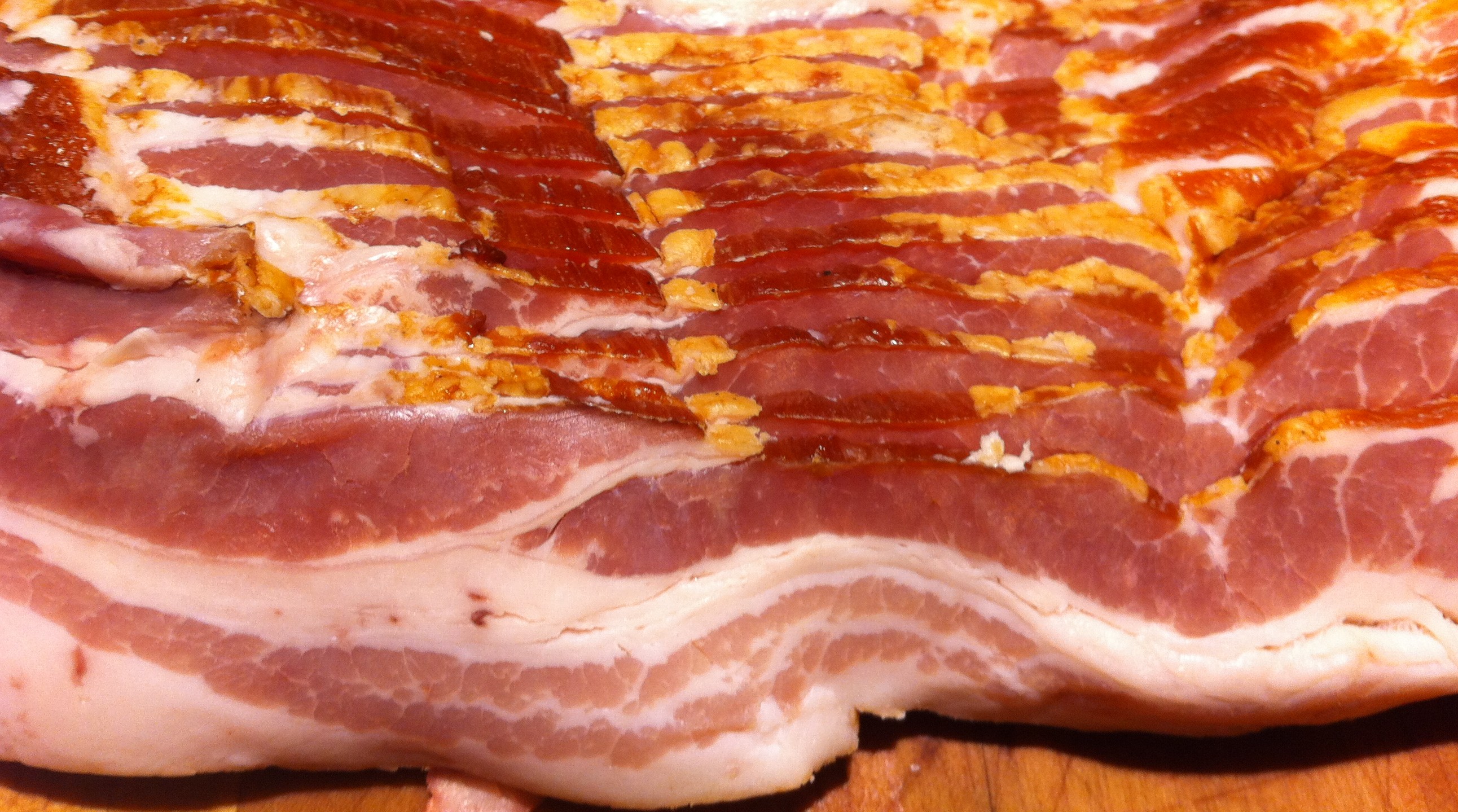
Bacon
It’s been said there are only two types of people in the world: people who love it…and people who love it but won’t admit it; it’s meat candy, the gateway meat for vegetarians, dogs beg for it, you either like it- or you’re wrong. Yup, it’s bacon. We live in a bacon nation, and if you don’t eat bacon, you’re a terrorist.
Ok, for the record, I don’t actually believe that, but if you live in America you have probably noticed that our culture is becoming obsessed with bacon. We put bacon on our bacon, then wrap that in bacon, fry it in bacon grease, sprinkle it with bacon bits, and serve it with a side of bacon. It’s referred to as ‘bacon-mania’ and some say it’s becoming an epidemic. There are Bacon-of-the-month clubs, bacon festivals, bacon blogs, and bacon themed restaurants. If there is a way to put bacon on something or in something, it’s been done. And I’m not just talking about food, there is bacon flavored toothpaste, bacon lube, bacon clothing, Kevin Bacon made of bacon, you name it- it’s been bacon-nated. Although we have managed to take bacon to the extreme over the last 10 or so years, these greasy strips of wonder have managed to seduce the taste buds of humanity since….well, since the dawn of bacon.
Did you know:
In the twelfth century, a church in the English town of Dunmow promised a side of bacon to any married man who could swear before the congregation and God that he had not quarreled with his wife for a year and a day. A husband who could “bring home the bacon” was held in high esteem by the community for his patience and restraint.
A Brief History of Bacon
The salting and smoking of meat has been practiced since B.C. Pigs were first known to be domesticated in china around 4900 BC and were being raised in Europe around 1500 B.C. The Romans are given credit for improving pig breeding and spreading pork production throughout their empire. One of the first documented uses of bacon can be found in Apicius (the title of a collection of Roman cookery recipes); the cured pig meat was to be boiled with dried figs, then browned and served with a wine and pepper sauce. It was also a staple amongst the Roman Army; every group of eight soldiers had a frying pan to cook up their daily rations of bacon, or as it was known to them, petaso.
Etymologically, Bacon means meat from the ‘back of the animal.’ The word ‘bacon’ is derived from the German bakkon, which then turned into the French bako, and finally the English aquired the word in the 12th century where it became bacon, or bacoun. In referring to the tale above about bringing home the bacon, Geoffrey Chaucer mentions it in The Wife of Bath’s Tale and Prologue, circa 1395:
But never for us the flitch of bacon though,
That some may win in Essex at Dunmow.
Sometime in the 1770’s, an Englishman named John Harris is credited with developing the first commercial bacon-making company in Wiltshire, England, which is still considered the bacon capitol of the world (sorry America, we may have invented bacconaise and bacon breath mints, but we have to give credit where credit is due). In 1924 Oscar Meyer introduced pre-packaged and pre-sliced bacon to the American public, and sometime in the 1990’s when a country inn in Texas first served chicken-fried-bacon, marks the beginning of our deranged love affair with bacon.
What’s all the fuss about?
So what is this 8th wonder of the world and what is so frickin good about it that inspires men to not beat their wives for a year and a day just to get their hands on some? Ok- here’s the science: Bacon posses’ six ingredient characteristics of umami. Umami is the 5th of the five basic tastes (sweet, sour, bitter, salty, and now umami). 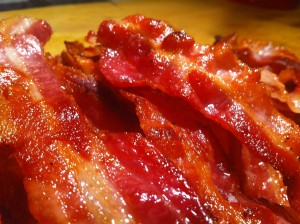 Haven’t heard of umami? It’s because we (in the western world) didn’t accept umami into our vernacular until 1985, although the taste was discovered, or actually was named, in 1908 by a Japanese scientist who wanted to describe what made certain foods palatable. From a biological perspective, umami is the built-in survival mechanism that enables the tongue to sense glutamate, which signals the presence of proteins in food the body needs. Umami is the same in every language and when broken down means ‘delicious taste’ in Japanese. When your taste buds sense the presence of umami, it triggers your brain to think, “This is delicious.”
Haven’t heard of umami? It’s because we (in the western world) didn’t accept umami into our vernacular until 1985, although the taste was discovered, or actually was named, in 1908 by a Japanese scientist who wanted to describe what made certain foods palatable. From a biological perspective, umami is the built-in survival mechanism that enables the tongue to sense glutamate, which signals the presence of proteins in food the body needs. Umami is the same in every language and when broken down means ‘delicious taste’ in Japanese. When your taste buds sense the presence of umami, it triggers your brain to think, “This is delicious.”
Bacon, for your health!
Some people credit this boom in bacon-mania to the theory that declaring your love of bacon is like packing our health-obsessed culture into a cigarette, smoking it, and ashing it into a salad at a weight watchers meeting. 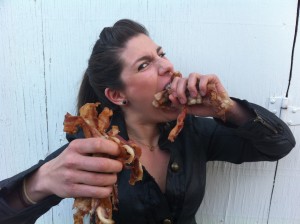 You don’t run around in spandex drinking wheat grass and green tea- you eat bacon, dammit! You’re the modern day James Dean; a true rebel. This mentality is due to the fact that bacon (and the rendered fat from pigs, aka lard) has gotten an, undeserved, bad reputation in America. There are two things that have made bacon a target in the health industry; the first is the use of nitrates and nitrites. Read more about these here and why they aren’t the cigarettes of the food industry, as we’ve been led to believe. The second is FAT! The current state of our culture loves to hate fat. Besides trans fat (man-made, labrotory fat), saturated fat is the one doctors warn you about the most (although that mentality is currently shifting, check out this article that debunks some of the myths of saturated fats). It has become ingrained in our thinking that all animal fat is saturated fat and by consuming it you’re knocking on death’s door. Well it might surprise you to know that pork fat is primarily mono-unsaturated fat. Yup- you read that correctly, mono-unsaturated, i.e., the stuff found in avocados, olives, nuts, all the other good fats we’re supposed to eat more of. The fat in bacon is 46% mono-unsaturated fat, about 38-40% saturated fat, and the rest is mostly polyunsaturated fat. If you’re really a health nut you might try and argue with me about the ratio of omega-3 to omega-6 fatty acids; well then get yourself some grass-fed or wild hogs (grass-fed meat is higher in omega-3’s than grain fed meat), make your own bacon, and you’ve now got a product that is high in omega-3’s and mono-unsaturated fat.
You don’t run around in spandex drinking wheat grass and green tea- you eat bacon, dammit! You’re the modern day James Dean; a true rebel. This mentality is due to the fact that bacon (and the rendered fat from pigs, aka lard) has gotten an, undeserved, bad reputation in America. There are two things that have made bacon a target in the health industry; the first is the use of nitrates and nitrites. Read more about these here and why they aren’t the cigarettes of the food industry, as we’ve been led to believe. The second is FAT! The current state of our culture loves to hate fat. Besides trans fat (man-made, labrotory fat), saturated fat is the one doctors warn you about the most (although that mentality is currently shifting, check out this article that debunks some of the myths of saturated fats). It has become ingrained in our thinking that all animal fat is saturated fat and by consuming it you’re knocking on death’s door. Well it might surprise you to know that pork fat is primarily mono-unsaturated fat. Yup- you read that correctly, mono-unsaturated, i.e., the stuff found in avocados, olives, nuts, all the other good fats we’re supposed to eat more of. The fat in bacon is 46% mono-unsaturated fat, about 38-40% saturated fat, and the rest is mostly polyunsaturated fat. If you’re really a health nut you might try and argue with me about the ratio of omega-3 to omega-6 fatty acids; well then get yourself some grass-fed or wild hogs (grass-fed meat is higher in omega-3’s than grain fed meat), make your own bacon, and you’ve now got a product that is high in omega-3’s and mono-unsaturated fat.
Bacon- it’s practically a vegetable.
Types of bacon
Here in the US of A, what we know as bacon is the cured belly of a pig. It’s called ‘streaky’ bacon (due to the streaks of fat and meat), but bacon can be made from other parts of the pig.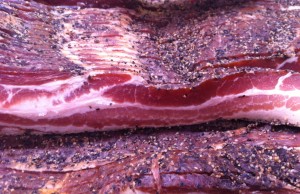 The other most common type of bacon is ‘back bacon’ (or as we call it, canadian bacon). It is made from the loin of the pig (think pork chops, but cured, smoked, and sliced thinner). In places like the U.K. and Ireland, back bacon is what you’ll get if you order bacon.
The other most common type of bacon is ‘back bacon’ (or as we call it, canadian bacon). It is made from the loin of the pig (think pork chops, but cured, smoked, and sliced thinner). In places like the U.K. and Ireland, back bacon is what you’ll get if you order bacon.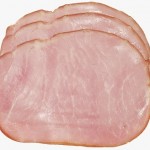 The streaky bacon that we know and love is referred to as ‘belly bacon’ or ‘American style’ bacon outside of the U.S. In fact, most other parts of the world identify bacon as the back bacon. A serving of bacon (several slices) is known as a ‘rasher’ of bacon. Bacon can also be made by smoking pigs cheeks, called ‘jowl bacon’, and from the shoulder, called ‘picnic bacon’ or ‘cottage bacon.’
The streaky bacon that we know and love is referred to as ‘belly bacon’ or ‘American style’ bacon outside of the U.S. In fact, most other parts of the world identify bacon as the back bacon. A serving of bacon (several slices) is known as a ‘rasher’ of bacon. Bacon can also be made by smoking pigs cheeks, called ‘jowl bacon’, and from the shoulder, called ‘picnic bacon’ or ‘cottage bacon.’
The Bad and the Ugly
Ok, I know you’re excited, but before you run out the door and start shoveling Wendy’s Baconators down your bacon chute, I have to discuss an issue that is important to me- animal welfare. Bacon doesn’t grow on tree’s; in order for us to enjoy this meat candy, pigs have to die (I’m really hoping this isn’t news to anyone…).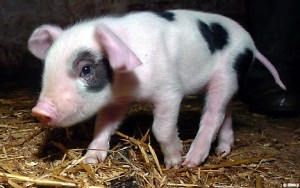 The majority of the bacon Americans consume comes from factory farmed pigs. Some of these industrialized pig farming methods include raising sows (the breeding pigs) in gestation crates; these crates are about two to three feet wide and don’t allow the pig enough room to roll over or stand up, they lie on slatted floors (for when they go to the bathroom; it just goes through the floor), and are moved to a ‘farrowing pen’ when they are to give birth. The sows have a few weeks with their piglets before they return to the gestation crate. The sows will spend their entire adult life in crippling pain, living in a crate that doesn’t allow them enough room to even roll over. This is one example of what goes on with intensive farming, and close to 90% of the pork we consume in America is a result of these methods. There are companies out there that offer humanely raised pork products, but they are fewer and far between and need your support. Please, Bacon Responsibly.
The majority of the bacon Americans consume comes from factory farmed pigs. Some of these industrialized pig farming methods include raising sows (the breeding pigs) in gestation crates; these crates are about two to three feet wide and don’t allow the pig enough room to roll over or stand up, they lie on slatted floors (for when they go to the bathroom; it just goes through the floor), and are moved to a ‘farrowing pen’ when they are to give birth. The sows have a few weeks with their piglets before they return to the gestation crate. The sows will spend their entire adult life in crippling pain, living in a crate that doesn’t allow them enough room to even roll over. This is one example of what goes on with intensive farming, and close to 90% of the pork we consume in America is a result of these methods. There are companies out there that offer humanely raised pork products, but they are fewer and far between and need your support. Please, Bacon Responsibly.
Makin’ Bacon
There are several ways to make bacon, but they all involve curing your meat with either a wet cure (brine) or a dry cure, and smoking your meat by using a hot smoking or cold smoking method. We will be doing all of this at Steaks and Chops and describing (in great, lengthy detail) how to make all sorts of bacon in all sorts of ways. Many methods are quite easy, and some rather time-consuming, but making your own bacon is a satisfying and fun hobby. Most supermarket bacon is pumped with water (so you’re paying for about 10% water, not meat) which is also why it shrinks up so much. The smoky taste in commercial bacon is usually due to liquid smoke, not from an authentic smoking process. By making your own bacon you’ll be able to experience the taste and texture of what true bacon is meant to be.
Well, there you have it folks, all you ever wanted to know about bacon. Probably more than you ever wanted to know about bacon…but knowledge is power, and bacon is awesome, so…uh…Viva la Bacon!
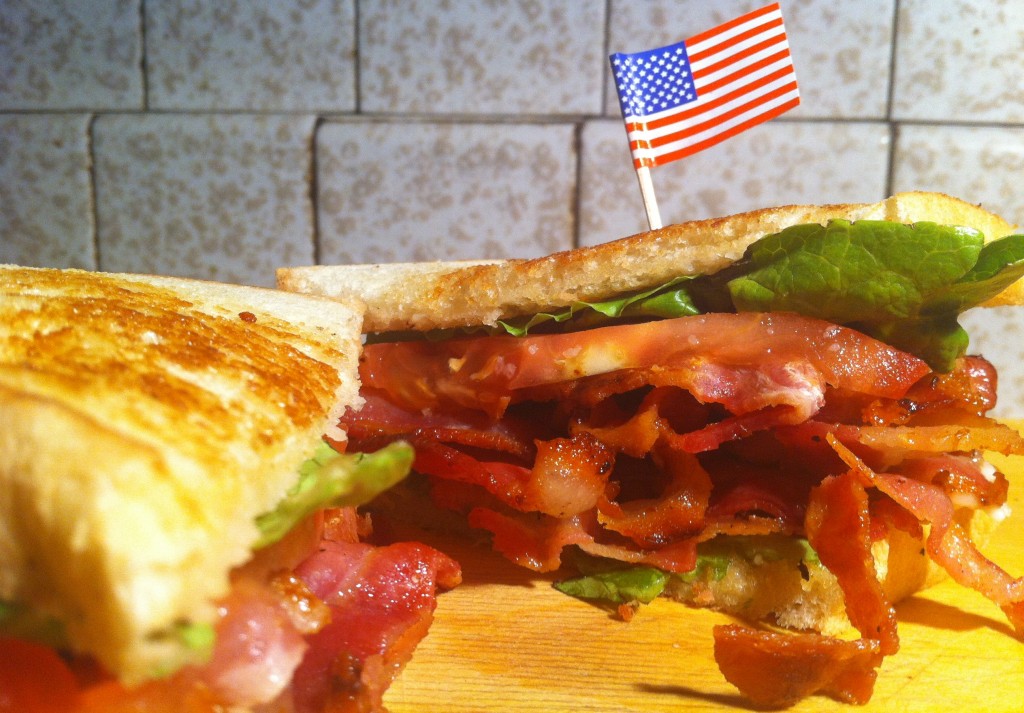
6 thoughts on “Bacon”
Great Blog and great writing. I will cherck in often
Hi John! Thanks for checking it out.
Hi mom,
Stores like Whole Foods and Trader Joes carry these products, but you can always check local farmer’s markets to see if there are ranches around where you live. You can also find humanely raised pork online. Some good sites are eatwild.com- this site lists all the ranches in your state that meet qualifications for animal welfare and how they feed their animals. Grass-fed pork is harder to find and I only found one farm that ships their products at texasgrassfedbeef.com, but some other good options for pork products are flyingpigsfarm.com and goodearthfarms.com.
thanks Sarah,
i will check out those web sites.
Loved this Sarah… I’m not a bacon freak but favor pork and am delighted to learn I’m gettting my Omega 3’s without having to eat fish flushed with petroleum and powered by PCB’s…
Hi,
love the post, I never knew where the exprssion “bringing home the bacon” came from…but have a question:
How do we know (and where do we find) humanely raised pork products?
Comments are closed.